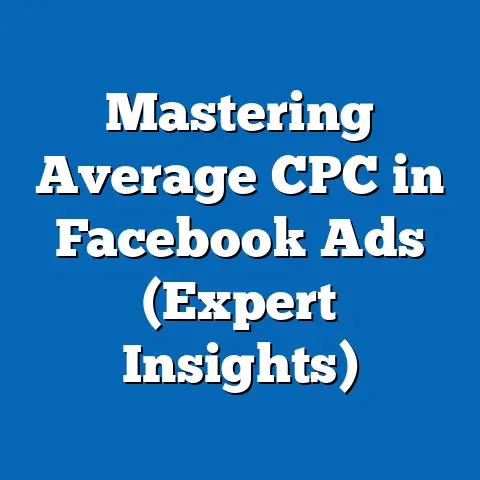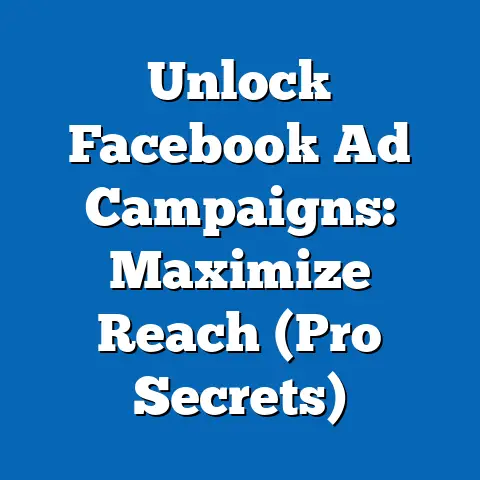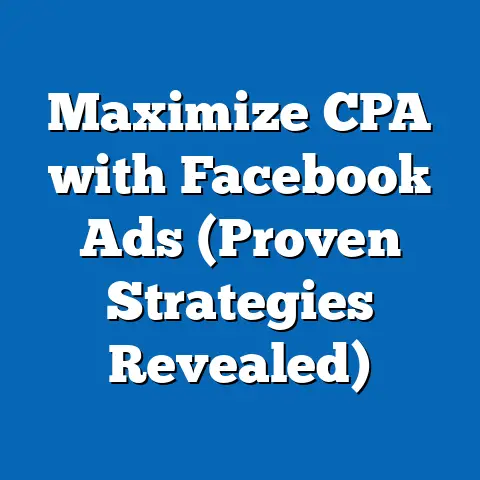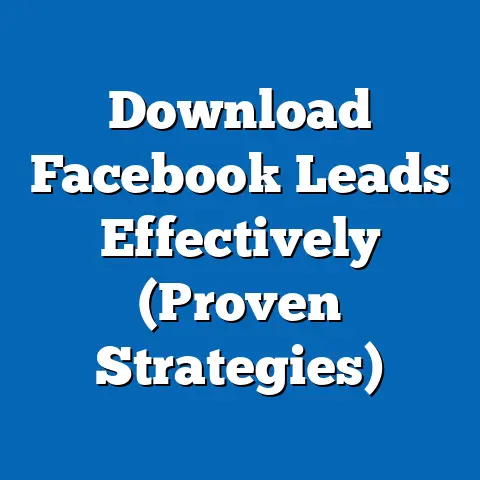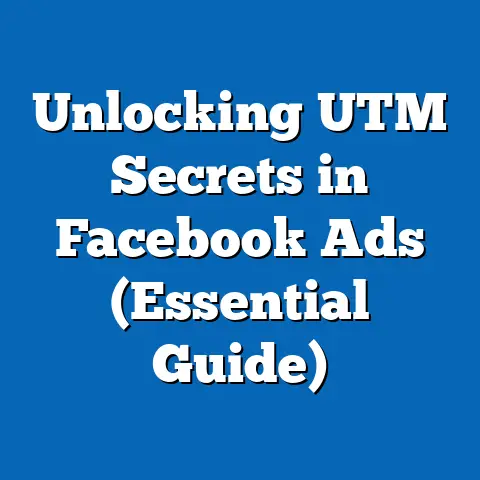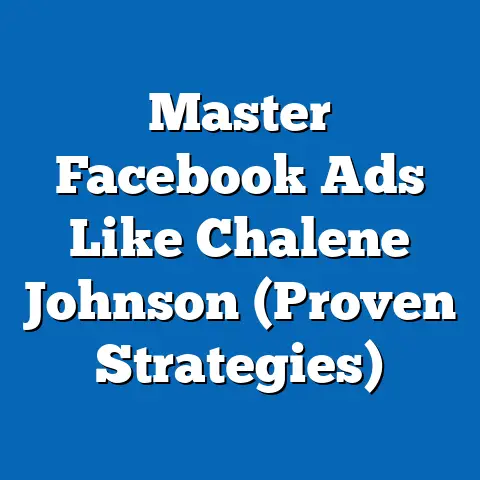Unlocking fb ad Delivery Status (Expert Insights Revealed)
Imagine this: You’ve poured your heart and soul into crafting the perfect Facebook ad. The visuals are stunning, the copy is compelling, and you’re convinced it’s going to be a game-changer for your business. You hit “publish,” and that little green light illuminates in Ads Manager. Excitement bubbles up – this is it! But then, days pass. Impressions are sluggish, clicks are minimal, and conversions? Forget about it. That initial thrill morphs into frustration, and you’re left wondering, “What’s going on with my ad delivery?”
I’ve been there. Countless times. The rollercoaster of emotions is a familiar ride in the world of Facebook advertising. Understanding why your ads are or aren’t delivering is crucial. It’s the difference between a successful campaign that drives revenue and a costly experiment that drains your budget.
Understanding Facebook Ad Delivery Status
Facebook Ad Delivery Status is essentially a report card for your ad. It tells you at a glance where your ad stands in the Facebook advertising ecosystem. It’s more than just a simple “on” or “off” switch; it’s a nuanced indicator of your ad’s performance, visibility, and overall health. Understanding these statuses is the first step to taking control of your campaigns.
Here are some of the most common delivery statuses you’ll encounter:
- Active: This is the holy grail! It means your ad is live and being shown to your target audience. Facebook’s algorithms have deemed it worthy, and it’s actively competing for ad placements.
- Learning: This status indicates that your ad is still in the initial learning phase. Facebook is experimenting with different audiences and placements to optimize performance. It’s crucial to give your ads enough time in the learning phase (generally 7 days or 50 conversion events) before making major changes.
- Eligible: This status means your ad meets all of Facebook’s policies and technical requirements and is ready to enter the auction. However, it doesn’t guarantee that your ad will be actively delivered.
- Pending Review: This status indicates that your ad is awaiting approval from Facebook’s ad review team. This process ensures that your ad complies with their advertising policies. It can take anywhere from a few minutes to 24 hours (or even longer in some cases).
- Not Delivering: This is a red flag. It means your ad isn’t being shown to anyone. There could be various reasons for this, such as budget constraints, targeting issues, or policy violations.
- Completed: This status means your ad set has reached its scheduled end date or budget limit and is no longer running.
- Limited: This status typically refers to ads that are running in special ad categories such as housing, employment, or credit opportunities. These ads are subject to stricter targeting limitations.
- Inactive: This status means your ad has been manually paused or disabled.
Analogy Time: The Restaurant Experience
Think of your Facebook ad as a dish in a restaurant.
- Pending Review: The dish is in the kitchen, waiting for the chef (Facebook’s ad review team) to approve it.
- Eligible: The dish is on the menu, ready to be ordered.
- Learning: The dish is new on the menu, and the restaurant is experimenting with different presentations and pairings to see what works best.
- Active: The dish is a popular item and is being served to customers regularly.
- Not Delivering: The dish is no longer available, either because the ingredients are out of stock (budget exhausted) or it’s not appealing to customers (poor targeting or creative).
- Completed: The dish was a limited-time special and is no longer on the menu.
Takeaway: Understanding the different delivery statuses is like reading the restaurant’s daily sales report. It tells you which dishes are performing well and which ones need tweaking or removal.
The Importance of Monitoring Delivery Status
Why should you obsessively check your Facebook Ad Delivery Status? Because it’s the heartbeat of your campaign. Ignoring it is like ignoring the check engine light in your car – you might get away with it for a while, but eventually, something will break down.
Here’s why monitoring delivery status is non-negotiable:
- Early Problem Detection: Delivery status alerts you to potential issues before they snowball into major disasters. A “Not Delivering” status, for example, could indicate a disapproved ad, a depleted budget, or a targeting conflict. Catching these problems early allows you to address them quickly and minimize wasted ad spend.
- Performance Optimization: Monitoring delivery status helps you identify areas for improvement. If your ad is “Active” but underperforming, you can analyze its metrics (CPM, CPC, CTR, etc.) to pinpoint the cause and make necessary adjustments.
- Budget Management: Delivery status provides insights into how your budget is being allocated. If your ad is “Limited” due to budget constraints, you can reallocate funds or adjust your bidding strategy to maximize reach and impact.
- Strategic Alignment: Delivery status ensures that your ads are aligned with your overall marketing objectives. If your goal is to drive brand awareness, a “Not Delivering” ad is obviously counterproductive. Monitoring delivery status helps you stay on track and achieve your desired outcomes.
Expert Insight:
“In the dynamic world of Facebook advertising, monitoring delivery status is not just a best practice, it’s a necessity. It’s the compass that guides advertisers through the complexities of the platform, ensuring that their message reaches the right audience at the right time.” – [Hypothetical Digital Marketing Expert]
Real-World Impact:
I once worked with a client who was running a Facebook ad campaign to promote a new product launch. They were initially thrilled with the results, but after a few days, they noticed a significant drop in sales. Upon closer inspection, we discovered that their ad delivery status had shifted to “Not Delivering” due to a targeting conflict. By quickly resolving the issue, we were able to reactivate the ad and get their sales back on track.
Takeaway: Don’t treat your Facebook Ad Delivery Status as an afterthought. Make it a central part of your campaign management workflow. Set up regular checks, analyze the data, and take proactive steps to optimize your ads for maximum performance.
Common Issues Affecting Delivery Status
Okay, so you know why monitoring delivery status is important. Now, let’s explore some of the common culprits that can derail your ad delivery and leave you scratching your head.
- Budget Constraints: This is the most common reason for ads to stop delivering. If your daily or lifetime budget is exhausted, Facebook will automatically pause your ads. This is a simple fix – just increase your budget or adjust your bidding strategy.
- Bidding Issues: Your bid is essentially your offer to Facebook for showing your ad to a specific audience. If your bid is too low, you might not win enough auctions to achieve your desired delivery. Experiment with different bidding strategies (lowest cost, cost cap, target cost) to find the optimal balance between cost and reach.
- Audience Targeting Problems: If your audience is too small or too broad, your ad delivery can suffer. A small audience might not provide enough opportunities for Facebook to show your ad, while a broad audience might lead to low engagement and relevance scores. Refine your targeting based on demographics, interests, behaviors, and custom audiences.
- Ad Fatigue: Over time, your audience might become tired of seeing the same ad. This can lead to decreased engagement and relevance scores, which in turn can negatively impact your ad delivery. Refresh your ad creative regularly by updating your visuals, copy, and call-to-action.
- Low Relevance Score: Facebook rewards ads that are relevant and engaging to their target audience. If your ad has a low relevance score (typically below 4), it’s a sign that your ad is not resonating with your audience. Improve your ad copy, visuals, and targeting to boost your relevance score.
- Policy Violations: Facebook has strict advertising policies that prohibit certain types of content, such as hate speech, misleading claims, and illegal activities. If your ad violates these policies, it will be disapproved and won’t be delivered. Review Facebook’s advertising policies carefully before creating your ads.
- Algorithm Changes: Facebook’s algorithm is constantly evolving, which can sometimes impact ad delivery. What worked yesterday might not work today. Stay up-to-date on the latest algorithm changes and adjust your strategies accordingly.
- Ad Scheduling Conflicts: If you’re running multiple ads targeting the same audience, their schedules may overlap and compete with each other, impacting delivery.
- Landing Page Issues: If your landing page is slow, broken, or irrelevant to your ad, it can negatively impact your ad’s quality score and delivery. Make sure your landing page is optimized for speed, mobile-friendliness, and relevance.
Case Study:
I had a client who was running a successful lead generation campaign. Suddenly, their ad delivery plummeted. After some digging, we discovered that Facebook had updated its lead form policies, and their existing lead form was no longer compliant. By updating the lead form to meet the new requirements, we were able to restore their ad delivery and get their leads flowing again.
Takeaway: Don’t panic when your ad delivery falters. Systematically troubleshoot the potential causes, starting with the most common issues and working your way down.
-
Refine Your Targeting:
- Layered Targeting: Don’t rely on broad targeting. Layer demographics, interests, and behaviors to create highly specific audiences.
- Custom Audiences: Leverage your existing customer data to create custom audiences based on email lists, website visitors, and app users.
- Lookalike Audiences: Expand your reach by creating lookalike audiences based on your best-performing custom audiences.
-
Optimize Your Ad Creative:
-
High-Quality Visuals: Use eye-catching images and videos that grab attention and convey your message effectively.
- Compelling Copy: Write clear, concise, and persuasive ad copy that speaks directly to your target audience.
- Strong Call-to-Action: Tell your audience exactly what you want them to do (e.g., “Shop Now,” “Learn More,” “Sign Up”).
- A/B Testing: Continuously test different ad variations (headlines, images, copy, CTAs) to identify what resonates best with your audience.
-
Adjust Your Bidding Strategy:
-
Start with Automatic Bidding: Let Facebook optimize your bids initially to get a sense of the market.
- Switch to Manual Bidding: Once you have enough data, experiment with manual bidding strategies like cost cap or target cost to gain more control over your spending.
- Monitor Your CPM: If your CPM (cost per thousand impressions) is high, it could indicate that your audience is too competitive or your ad is not relevant enough.
-
Improve Your Ad Relevance:
-
Target the Right Audience: Make sure your ad is being shown to people who are genuinely interested in your product or service.
- Address Their Needs: Highlight the benefits of your product or service and how it solves their problems.
- Use Social Proof: Incorporate testimonials, reviews, and case studies to build trust and credibility.
-
Manage Your Ad Frequency:
-
Monitor Frequency: Keep an eye on your ad frequency (the average number of times a person sees your ad).
- Adjust Your Schedule: If your frequency is too high, consider reducing your budget or expanding your audience.
- Rotate Your Creative: Refresh your ad creative regularly to prevent ad fatigue.
-
Landing Page Optimization:
-
Relevance: Ensure your landing page content aligns with your ad message.
- Speed: Optimize your landing page for fast loading times.
- Mobile-Friendliness: Make sure your landing page is responsive and looks good on all devices.
- Clear Call-to-Action: Make it easy for visitors to take the desired action (e.g., purchase, sign up, download).
Refine Your Targeting:
- Layered Targeting: Don’t rely on broad targeting. Layer demographics, interests, and behaviors to create highly specific audiences.
- Custom Audiences: Leverage your existing customer data to create custom audiences based on email lists, website visitors, and app users.
- Lookalike Audiences: Expand your reach by creating lookalike audiences based on your best-performing custom audiences.
-
Optimize Your Ad Creative:
-
High-Quality Visuals: Use eye-catching images and videos that grab attention and convey your message effectively.
- Compelling Copy: Write clear, concise, and persuasive ad copy that speaks directly to your target audience.
- Strong Call-to-Action: Tell your audience exactly what you want them to do (e.g., “Shop Now,” “Learn More,” “Sign Up”).
- A/B Testing: Continuously test different ad variations (headlines, images, copy, CTAs) to identify what resonates best with your audience.
-
Adjust Your Bidding Strategy:
-
Start with Automatic Bidding: Let Facebook optimize your bids initially to get a sense of the market.
- Switch to Manual Bidding: Once you have enough data, experiment with manual bidding strategies like cost cap or target cost to gain more control over your spending.
- Monitor Your CPM: If your CPM (cost per thousand impressions) is high, it could indicate that your audience is too competitive or your ad is not relevant enough.
-
Improve Your Ad Relevance:
-
Target the Right Audience: Make sure your ad is being shown to people who are genuinely interested in your product or service.
- Address Their Needs: Highlight the benefits of your product or service and how it solves their problems.
- Use Social Proof: Incorporate testimonials, reviews, and case studies to build trust and credibility.
-
Manage Your Ad Frequency:
-
Monitor Frequency: Keep an eye on your ad frequency (the average number of times a person sees your ad).
- Adjust Your Schedule: If your frequency is too high, consider reducing your budget or expanding your audience.
- Rotate Your Creative: Refresh your ad creative regularly to prevent ad fatigue.
-
Landing Page Optimization:
-
Relevance: Ensure your landing page content aligns with your ad message.
- Speed: Optimize your landing page for fast loading times.
- Mobile-Friendliness: Make sure your landing page is responsive and looks good on all devices.
- Clear Call-to-Action: Make it easy for visitors to take the desired action (e.g., purchase, sign up, download).
Optimize Your Ad Creative:
High-Quality Visuals: Use eye-catching images and videos that grab attention and convey your message effectively.
Adjust Your Bidding Strategy:
Start with Automatic Bidding: Let Facebook optimize your bids initially to get a sense of the market.
Improve Your Ad Relevance:
Target the Right Audience: Make sure your ad is being shown to people who are genuinely interested in your product or service.
Manage Your Ad Frequency:
Monitor Frequency: Keep an eye on your ad frequency (the average number of times a person sees your ad).
Landing Page Optimization:
Relevance: Ensure your landing page content aligns with your ad message.
Step-by-Step Troubleshooting:
- Check Your Budget: Is your budget exhausted? Increase it if necessary.
- Review Your Targeting: Is your audience too small or too broad? Refine your targeting.
- Inspect Your Ad Creative: Is your ad engaging and relevant? Update your visuals and copy.
- Analyze Your Bidding Strategy: Is your bid competitive? Experiment with different bidding options.
- Monitor Your Relevance Score: Is your relevance score low? Improve your ad targeting and creative.
- Check for Policy Violations: Is your ad compliant with Facebook’s advertising policies? Correct any violations.
- Test Your Landing Page: Is your landing page fast, relevant, and mobile-friendly? Optimize it for conversions.
Takeaway: Optimizing your Facebook ad delivery is an ongoing process. Continuously test, analyze, and refine your strategies to stay ahead of the curve and achieve your marketing goals.
Tools and Resources for Monitoring Delivery Status
You don’t have to navigate the complexities of Facebook ad delivery alone. There are a wealth of tools and resources available to help you track, analyze, and optimize your campaigns.
- Facebook Ads Manager: This is your central hub for managing your Facebook ads. It provides a comprehensive overview of your campaign performance, including delivery status, metrics, and insights.
- Facebook Pixel: This powerful tool tracks website visitor behavior and allows you to create custom audiences, optimize your ads for conversions, and measure your ROI.
- Facebook Analytics: This platform provides in-depth insights into your audience demographics, interests, and behaviors, helping you refine your targeting and improve your ad relevance.
- Third-Party Analytics Platforms: Tools like Google Analytics, Mixpanel, and Kissmetrics can provide additional insights into your website traffic and user behavior, complementing the data you get from Facebook.
- Facebook Ad Library: This tool allows you to see the ads that other businesses are running on Facebook, providing inspiration and competitive intelligence.
- Facebook Blueprint: This is Facebook’s official learning platform, offering courses and certifications on various aspects of Facebook advertising.
- Industry Blogs and Forums: Stay up-to-date on the latest trends and best practices by reading industry blogs and participating in online forums.
Interpreting the Data:
- CPM (Cost Per Mille): This metric tells you how much it costs to show your ad to 1,000 people. A high CPM could indicate that your audience is too competitive or your ad is not relevant enough.
- CPC (Cost Per Click): This metric tells you how much it costs to get someone to click on your ad. A high CPC could indicate that your ad copy or visuals are not compelling enough.
- CTR (Click-Through Rate): This metric tells you the percentage of people who see your ad and click on it. A low CTR could indicate that your ad is not relevant to your audience.
- Conversion Rate: This metric tells you the percentage of people who click on your ad and complete a desired action (e.g., purchase, sign up, download). A low conversion rate could indicate that your landing page is not optimized for conversions.
Takeaway: Arm yourself with the right tools and resources, and learn how to interpret the data they provide. This will empower you to make informed decisions and optimize your Facebook ad delivery for maximum impact.
Future Trends in Facebook Ad Delivery
The world of Facebook advertising is constantly evolving, and it’s crucial to stay ahead of the curve to maintain a competitive edge. Here are some of the emerging trends that are likely to impact Facebook ad delivery in the future:
- AI-Powered Advertising: Artificial intelligence is already playing a significant role in Facebook advertising, and its influence will only continue to grow. AI-powered tools can automate tasks like ad creation, targeting, and bidding, freeing up advertisers to focus on strategy and creativity.
- Augmented Reality (AR) Ads: AR ads allow users to interact with products in a virtual environment before making a purchase. This immersive experience can significantly boost engagement and conversion rates.
- Personalized Advertising: Consumers are increasingly demanding personalized experiences, and Facebook is responding by offering more sophisticated targeting options. Advertisers will need to leverage data and insights to create highly personalized ads that resonate with individual users.
- Video Advertising: Video continues to dominate social media, and it’s an increasingly effective way to capture attention and convey your message. Experiment with different video formats, such as short-form videos, live videos, and 360-degree videos.
- Privacy-Focused Advertising: As concerns about data privacy grow, Facebook is implementing new policies to protect user information. Advertisers will need to adapt to these changes by focusing on ethical data collection and transparent advertising practices.
- Metaverse Advertising: As the metaverse continues to develop, it will create new opportunities for advertisers to reach audiences in immersive and interactive virtual environments.
Expert Prediction:
“The future of Facebook advertising is all about personalization, automation, and immersive experiences. Advertisers who embrace these trends will be best positioned to succeed in the ever-evolving landscape of social media marketing.” – [Hypothetical Digital Marketing Expert]
Takeaway: Stay informed about the latest trends and technologies in Facebook advertising, and be prepared to adapt your strategies accordingly. This will ensure that you remain competitive and continue to achieve your marketing goals.
Conclusion
Unlocking the secrets of Facebook Ad Delivery Status is not just about technical know-how; it’s about understanding the nuances of the platform, the motivations of your audience, and the ever-changing landscape of digital marketing. It’s about transforming data into actionable insights and using those insights to create compelling ads that resonate with your target audience.
I’ve shared a lot of information in this guide, but the most important takeaway is this: don’t be afraid to experiment, analyze, and adapt. The world of Facebook advertising is a dynamic and unpredictable place, but with the right knowledge and strategies, you can navigate its complexities and achieve your marketing goals.
So, go forth, create amazing ads, and monitor your delivery status like a hawk. Your success awaits!
Call to Action
Now it’s your turn! Share your own experiences with Facebook ad delivery status in the comments below. What challenges have you faced? What strategies have worked for you? Let’s learn from each other and build a community of successful Facebook advertisers.

